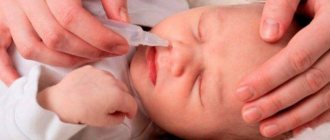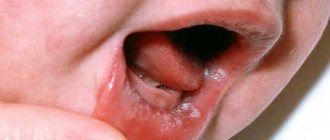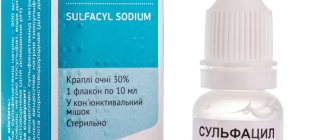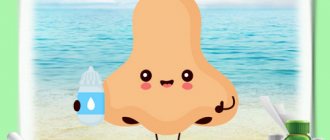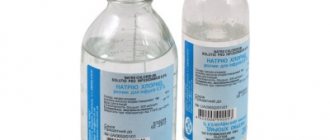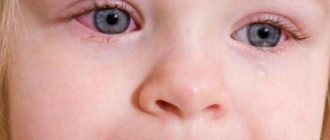Antiviral agents
How to properly treat a runny nose? It is necessary to fight the cause of the disease – the virus. This task is accomplished by drugs containing interferon and other immunomodulatory substances. One of them is Derinat, produced in the form of drops and liquid for injection. In pediatrics, the first option is used.
The main component of Derinat is sodium deoxyribonucleate (2.5 mg/1 ml). Its action:
- mucosal regeneration
- reduction of inflammation
- stimulating cellular defense, thereby enhancing the immune response when fungi, viruses and bacteria enter the body
"Derinat" is prescribed for the prevention and treatment of diseases of the upper respiratory tract. The drug speeds up recovery and reduces the likelihood of complications.
Regimen for taking Derinat solution for acute respiratory infections:
- treatment on the first day - 2-3 drops in both nostrils with an interval of 1.5 hours
- therapy, starting from day 2 - 2-3 drops 3-4 times a day
- prevention – 2 drops 2-4 times a day
You can drip Derinat from the first days of life.
Other antiviral drugs for administration into the nose are “Nazoferon”, “Grippferon”, “Genferon-Lite”, “Leukocyte Interferon”. Their active substance (interferon) is characterized by antiviral and immunostimulating properties.
Medicines that contain synthetic (recombinant) rather than leukocyte interferon are considered safer. They are allowed to be used in newborn babies. Approximate dosage – 1 drop 5 times a day.
E.O. Komarovsky believes that the use of antiviral drugs for ARVI, including Derinat drops and products containing interferon, is justified if the baby’s immunity is very weakened.
Indications
Sulfacyl sodium is in demand in the treatment of:
- infectious inflammation of the eyelids (purulent blepharitis);
- bacterial conjunctivitis (including those caused by chlamydia or gonococcus);
- purulent inflammation of the lacrimal canal or lacrimal sac;
- purulent ulcers on the surface of the cornea.
The drug is also used for prophylactic purposes (for example, for burns or eye injuries) to prevent infection. In addition, Sulfacyl sodium is the drug of choice to prevent the development of blenorrhea. This is the name for a conjunctival infection caused by gonococcus, which is usually diagnosed in newborns who become infected from the mother during childbirth. To prevent such infection, Sodium Sulfacyl is given to babies in the first hours after birth.
What is the medicine
Albucid - eye drops for bacterial conjunctivitis. But it is also taken as a remedy for sinusitis, rhinitis, sinusitis and other nasal diseases. This medicine has antibacterial and antimicrobial action. It is absolutely safe and non-addictive.
Since the composition includes saline and sodium sulfacyl, its action is aimed at destroying purulent snot and the bacteria that cause it: cocci, chlamydia, toxoplasmoids. Even small children can drip it.
Albucid helps in cases where the disease is purulent in nature. It has a positive and more successful effect than the use of antibiotics. It is prescribed when the baby develops so-called “green snot”. It can be used from a very early age, since the child’s body does not get used to the medicine, and also does not cause disruption of the natural microflora of the mucous membrane in the nasal cavity and throat.
Storage conditions
Most manufacturers recommend storing drops at temperatures below +15 degrees, but avoid freezing. To store the drug, you must choose a place that will be inaccessible to children.
The shelf life of Sulfacyl Sodium before the first use of the medication is 2 years. From the moment the bottle or tube is opened, it decreases: some manufacturers recommend throwing away the drug after 14 days, others - after 28 or 30 days - more precise information should be specified in the instructions for the medicine.
Indications and contraindications for use
Infectious and inflammatory eye diseases:
- Purulent ulcer of the cornea (the source is often purulent dacryocystitis);
- Panophthalmitis (infected with pneumococci, streptococci);
- Conjunctivitis;
- Blepharitis (inflammation of the edges of the eyelid);
- Keratitis (inflammation of the cornea, the presence of infiltrates in it);
- It is successfully used for the prevention of blenorrhea (gonococcal conjunctivitis. Causative agent - Neisser's gonococcus) in newborns.
Intramuscular administration is prescribed for the treatment of urinary tract infections and other diseases of the genitourinary system.
Streptoderma and staphyloderma are treated with the drug. Also used to treat infected wounds.
Used to treat rhinitis if the cause of the disease is pathogens that are sensitive to drugs of the sulfonamide group. This is a good alternative to antibiotic treatment for rhinitis of bacteriological etiology.
In this regard, doctors began to prescribe sodium sulfacyl for the treatment of a runny nose. But this is only if the runny nose is bacterial. And the fact that it is bacteria that cause rhinitis (sinusitis) will be indicated by characteristic symptoms - yellowish-green mucus is released from the nose.
Now, if you put drops in your nose, following the doctor’s advice, there will be a noticeable relief in the breathing process, and there will be much less discharge. How to treat sinusitis in children is described in this material.
Before instilling the drug into the nose, you must:
- Rinse the nasal passages with saline or saline solution. If you don’t have a ready-made sterile one, you can boil water and make it yourself. To do this, per liter of warm boiled water you will need two level teaspoons of sea or simple kitchen salt;
- The solution should be filtered before use;
- Instill vasoconstrictor drugs - Tizin, Galazolin;
- Drop sodium sulfacyl into the nasal passages. First in one nostril, and then, without getting up from your seat and turning your head to the side, into the second.
Before use, you need to screw the cap all the way so that its spike makes a hole through which you can then drip liquid. Hold the bottle in your hands for a short time so that the temperature of the solution is closer to normal human body temperature. More often, sodium sulfacyl for a runny nose is prescribed by pediatricians for children under six months, 1 drop three times a day in each nostril for 7 days.
Drop two drops into each nostril three times a day for adults and children over twelve years of age. The final step will be to instill moisturizing drops or ointments into the nose so that the nasal mucosa does not dry out. This is especially true for children.
Contraindications for use:
- Intolerance to sulfonamides;
- The drugs Anestezin and Novocain reduce the effectiveness of sodium sulfacyl;
- It is not advisable to use during pregnancy or lactation.
How to cure a runny nose during pregnancy is described in this article.
In rare cases, when instilling sodium sulfacyl into the nose, slight redness, slight swelling, and itching may be observed.
Is it possible to use drops for a runny nose during pregnancy?
There is not enough information about the presence of the active substance sodium sulfacyl in breast milk, so the attending physician must decide whether to use the drug or not, after weighing the pros and cons.
Dosage of the drug for small children and infants - instructions for use
Sulfacyl sodium can be instilled into the eyes of infants as a prophylactic against blenorrhea (a type of conjunctivitis in newborns. Inflammation of the mucous membrane of the eye, characterized by profuse suppuration).
It is also an effective remedy against runny nose (rhinitis) and even inflammatory processes in the ear. Typically, sodium sulfacyl is prescribed to children over one year old if they have a stuffy nose and a severe runny nose, 1 drop in each nostril at least three times a day for 7 days. From the age of six, with the same dose of undiluted drug (20% concentration) - 1-2 drops in the nostril. The instillation procedure is carried out four times a day. For newborn babies, a 20% solution is diluted with boiled water at a rate of 1:1. Features of using Snoop Spray are described here.
Is it possible to use Albucid drops in the nose of children? At what age is the drug prescribed?
In order to answer the question of whether it is possible to instill Albucid into the nose of children, it is necessary to determine what this drug is and what it is prescribed for. The medicine is available in the form of drops for both children and adults, differing only in the percentage of active substance content - sodium sulfacyl, or sulfacetamide. The main action of the component is aimed at eliminating bacteria such as streptococci, gonococci, E. coli, staphylococci, chlamydia, etc. Since a single dose of the substance is quite small, and the level of its absorption into the blood is quite low, “Albucid” can be instilled into the nose of children with almost no restrictions . It should be noted that newborns are prescribed the drug from the first minute of life to prevent eye diseases.
Effect of the drug
Albucid drops are an antimicrobial agent, the action of which is aimed at destroying the process of building amino acids in bacterial cells. As a result, the proliferation of pathogenic microorganisms stops. This drug has a wide range of effects, so it is often prescribed for various infections of the upper respiratory system.
For what kind of runny nose are these drops prescribed?
It should be noted that this medicine is not suitable for all cases of rhinitis. The drug "Albucid" in the nose is prescribed to children only when the runny nose is of a bacterial nature. At the early stage of the disease, mucous discharge from the nasal cavity is observed, which is often provoked by viruses, so prescribing the drug in this case is inappropriate and useless. The indication for the use of Albucid drops is a prolonged runny nose, which is accompanied by a bacterial infection.
Signs of a bacterial runny nose
- the presence of thick, sometimes foul-smelling discharge from the nasal cavity;
- greenish-yellow or green color of discharge;
- unsuccessful treatment of rhinitis with conventional medications.
In some cases, Albucid drops for children are more effective than other antibiotics. This is because the antimicrobial substances contained in nasal drops are often able to affect only a certain type of bacteria. When exposed to an insensitive pathogen, such an antibiotic, as a rule, does not work. Therefore, in order to find out whether Albucid can be given to a child, it is necessary to determine the exact cause of the runny nose, otherwise all treatment will be in vain.
Indications
For allergic rhinitis, the drug does not have a therapeutic effect. Therefore, before using this medicine, especially for young children, you should make sure that nasal discharge is not caused by the body’s reaction to teething. Infection of the nose is accompanied by greenish discharge, while allergies are characterized by clear and light-colored nasal discharge.
Contraindications
The drug "Albucid" for children (the instructions describe in detail all the properties and effectiveness of this medication) is an indispensable assistant for many young mothers, since it is quite simple to use.
Use of the medicine
To treat bacterial rhinitis, the drug “Albucid” should be instilled into each nostril, after first cleaning the mucous membrane by rinsing with saline and then blowing off the mucus. If necessary, use an aspirator.
If during the procedure the baby behaves restlessly and is constantly fidgeting, you can gently wipe his nose with a cotton swab dipped in water, while slightly tilting his head back. It has been noticed that the drug has a drying effect on the nasal mucosa, thereby reducing the amount of secretions. Sometimes a child may react sharply to the administration of a medicine, which is explained by a burning sensation, so mothers should not worry too much about this. By using drops, you ensure that the active substance reaches the very epicenter of the accumulation of microbes, thereby protecting your child from taking antibacterial agents internally.
Only a pediatrician can decide whether to use the drug “Albucid” or not, so at the first symptoms of a runny nose in your baby, be sure to consult a specialist. Modern pharmaceuticals are constantly creating and developing new drugs that can be more effective and act faster on the causative agent of the disease, so the help of a doctor will not be superfluous here.
fb.ru
Reviews
Most of the reviews left by parents and doctors about Sodium Sulfacyl call such drops effective and quite effective for conjunctivitis and other eye lesions. In addition, the advantages of the drug include the possibility of use from birth, as well as the prevalence of the drug in pharmacies and low cost.
According to most mothers, it is convenient to use the medication, and it acts quickly enough, helping to get rid of eye infections. Thanks to these features, “Sodium Sulfacyl” is often taken with you on trips or included in home first aid kits.
As for the disadvantages, most often parents mention unpleasant sensations after instillation. Many children protest against this medicine and complain of tingling and burning after use. When the medication is applied to the nose, a tingling discomfort and a bitter taste are also noted.
In addition, sodium sulfacyl did not help some children. This is usually due to the pathogen's resistance to sulfonamides and requires the prescription of antibiotics from other groups. The disadvantages of the drug also include a very short shelf life after the bottle or tube is opened.
Separately, there are reviews about the use of Albucid in the nose, which are also mostly positive. They call the remedy effective for purulent runny nose or prolonged rhinitis. However, many doctors, including the famous pediatrician Komarovsky, consider such treatment to be ineffective.
In their opinion, the product does not have time to act on the nasal mucosa, but enters the pharynx and is swallowed. They are confident that such eye drops should not be used in the nose, and for a runny nose, other medications that have proven themselves in the treatment of rhinitis, sinusitis or adenoiditis should be used.
Albucid for newborns
In this article we will talk about a popular drug for the treatment of infections in children - albucid. We will tell you how to use Albucid, at what age you can use it, whether newborns can receive Albucid infusions, are there any contraindications to the use of this drug, etc.
Application of albucid
Albucid is a drug belonging to the class of antibiotics, a derivative of sulfanilamide. In the international classifier it is called “sulfacetamide”. Previously, there were several forms of release of this drug - ointments, drops, injection solutions, but today the product is produced only in the form of drops. Two types of drops (for children and adults) differ in the concentration of the active substance. In the preparation for adults it is 30%, and in the preparation for children it is 20% sodium sulfacyl.
Indications for use:
- conjunctivitis and other diseases of the conjunctiva;
- lesions of the eyelid of various origins;
- eye damage due to gonorrhea;
- ulcers on the cornea (especially purulent);
- eye infections caused by bacteria susceptible to sulfacetamide;
- prevention of blenorrhea in children.
Albucid is eye drops; they can be used for newborns only after consultation with a pediatrician. An aqueous solution of sodium sulfacyl perfectly penetrates into all tissues and fluids of the eye, causing disruption in the functioning of bacterial cells, which causes the infection to fade. Albucid is freely available in pharmacies and does not require a prescription to purchase it.
Sometimes parents use albucid for infants as a remedy for the common cold. In most cases, the effectiveness of such treatment is quite high, but it should be remembered that albucid for newborns with a runny nose should never be used independently, without medical supervision. In addition, albucid for newborns in the nose is far from the best choice. Today, there are a number of more effective and safe remedies for the treatment of runny nose. The only medically recognized use of albucid is the treatment of infectious eye diseases.
Dosage:
Place 2 drops in each eye 2-6 times a day. The number of instillations per day and the duration of the course of treatment are determined only by the doctor, focusing on the type of disease, the severity of symptoms, the patient’s age and general state of health. Self-medication is unacceptable.
Albucid: contraindications
The drug should not be used if the patient has:
- allergy to drugs of the sulfonamide group;
- intolerance or hypersensitivity to sulfonylureas, thiazide diuretics or carbanhydrase inhibitors - in these cases, the likelihood of intolerance reactions to albucid increases.
Albucid cannot be used together with products that contain silver ions.
Prescribing the drug during pregnancy and lactation is possible, but with careful medical supervision and only in cases where the expected benefit to the mother outweighs the potential risk to the child.
In case of contact of albucid with soft contact lenses, the transparency of the latter may be impaired.
Cases of allergic reactions are extremely rare, but if you notice skin redness, itching, rash, swelling after using Albucid, immediately stop using the product and consult a doctor. The use of albucid should not be reinstated until all symptoms of intolerance have completely disappeared.
The drug should be stored in a dark and dry place, out of reach of children, at an air temperature no higher than 15°C. The shelf life of an opened bottle (subject to storage conditions) is 28 days.
WomanAdvice.ru
Possible side effects
Negative consequences associated with taking Albucid are extremely rare. The drug is usually well tolerated. Side effects develop with uncontrolled use or abuse of the drug.
Typical side effects:
- burning sensation;
- pain, pain in the larynx;
- lacrimation;
- irritation, itching in the nasal cavity;
- allergy.
If you notice any redness or swelling of the mucous membrane, you should consult a doctor. The most dangerous side effect is difficulty breathing. In this case, it is necessary to call an ambulance, since there is a risk of death due to oxygen starvation.
Other nasal drops
Below is a brief description of the most popular and most importantly effective nasal drops for young children.
Aquamaris
All children's doctors recognized it as the most harmless drug for instillation into the nose of a small child. It consists only of sea water and no dyes or preservatives. Therefore, it can be used literally from the first days.
Salin
Just like the above, Aquamaris belongs to saline solutions, but unlike the first drug, it also contains additional components. The bottle in which it is produced makes it possible to use the drug both in the form of drops and in the form of a spray (for older children). It can also be used from the first days of a child’s life.
Euphorbium compositum
Refers to homeopathic remedies with complex anti-inflammatory, antiallergic and immunostimulating effects. The drug serves not only as a cure for rhinitis, but can be used as a prophylactic against viral and colds in infants.
Now let's move on to drugs that are no less effective, but they are prescribed only by a doctor and treatment is carried out only under his supervision.
Nazol baby
The drug is a vasoconstrictor, so nasal mucus and congestion quickly go away. It has side effects such as dry mucous membranes. It can be addictive and, with prolonged use, causes worsening swelling and headaches.
Nazivin
Another vasoconstrictor drug made in Germany. The action is similar to that described above, but more short-term. For children, use a special children's product with a concentration of 0.01 percent. Side effects manifest themselves in the form of burning, anxiety, and lethargy.
Compound
The main component of the medicine is called sulfacetamide and is contained in the solution in an amount of 200 mg per 1 milliliter. In addition to it, the preparation often contains sodium thiosulfate, purified water and hydrochloric acid. Some manufacturers use sodium hydroxide and sodium disulfite as auxiliary components of the solution.
Is it possible to use Albucid eye drops to treat a runny nose?
It is indeed possible to use eye drops for a runny nose in children. They are often recommended by pediatricians themselves, because... The medicine is effective and quite safe. Its wide spectrum of action allows you to fight mixed infections.
Rules for using the medicine in pediatrics:
- Albucid is an antibiotic, so it is inactive against viruses. In this case, interferon is needed, and eye drops will be useless. Treatment can begin only after tests have been completed and the diagnosis has been confirmed.
- The medication is not used from the first days of a runny nose, when almost clear liquid flows from the nose. It is prescribed when microorganisms have “settled” in the upper respiratory tract and the mucus has turned yellow or green.
- For infants under 1 year of age, the drug is instilled, diluted with saline or clean drinking water to the required percentage of sodium sulfacyl. The dosage is determined by the pediatrician according to the age and condition of the patient. Albucid causes a slight burning sensation and dryness in the nose, so a diluted solution is gentler.
The medicine is included in some “complex” drops. This is a combined solution consisting of several drugs in certain proportions. They are prepared in pharmacies to order according to a doctor’s prescription. “Complex” drops can be prepared at home according to the pediatrician’s instructions.
Before instilling Albucid into a child’s nose, you should definitely clear the nasal passage of accumulated mucus. If the child is already able to blow his nose on his own, let him do it. And very young children can be cleaned using a weak saline or saline solution. Rinsing the nose is carried out with a regular cotton swab, which is moistened in one of the above solutions.
Note that for children, drops in the form of a 20 percent solution are indicated for the treatment of bacterial infections. To avoid a possible burning sensation, the concentration of the composition is reduced with ordinary boiled water. To do this, the product is diluted in water (1:1). A single dosage is usually 2 drops in each nostril.
3–4 instillations are performed daily; it is important to maintain equal time intervals between procedures. Treatment usually lasts from five days to a week
However, in each specific case, the required duration of therapy should be determined exclusively by the pediatrician. He also specifies the intensity of treatment.
Release form
Sulfacyl sodium is produced by many Russian pharmaceutical companies and manufacturers from neighboring countries. Sometimes the name of the medicine has a prefix indicating the company - DIA or MEZ. However, all of these drugs are identical to each other and contain the same active compound.
The only form of medication is eye drops with a concentration of the active compound of 20 percent. They are often sold in polymer dropper tubes or plastic dropper bottles. Some are in glass bottles with a dropper cap attached.
According to its physical characteristics, the medicine is a transparent liquid. It is usually colorless, but can also be light yellow. The amount of solution in one tube or bottle is 0.5 ml, 1 ml, 1.5 ml, 2 ml, 5 ml or 10 ml, and one pack can contain one, five, ten or more bottles.
Use of the medicine
The liquid also begins to actively react with pathogenic bacteria, destroying them and removing them from the body. At the same time, rapid cleansing of the mucous membranes of the nasal cavity occurs.
Albucid drops into a child's nose are prescribed for an average of five or seven days. In some cases, a shorter period of treatment is required. During this time, bacteria are completely removed from the respiratory tract, and the runny nose goes away.
If your baby is affected by a bacterial infection, then this treatment should help him. In case of viral diseases, parents note that the drug “Albucid” did not cope with the task.
The prognosis after correction is always favorable. Unlike other antibacterial and antimicrobial drugs, Albucid does not dry out the mucous membrane and does not disrupt beneficial microflora.
To treat bacterial rhinitis, the drug “Albucid” should be instilled into each nostril, after first cleaning the mucous membrane by rinsing with saline and then blowing off the mucus. If necessary, use an aspirator.
It should be noted that this medicine can have an irritating effect, so the dosage must be strictly observed. Before burying the baby's nose, it is recommended to dilute the solution with boiled water 1:1 to reduce the concentration of the active substance. No more than two drops of the drug should be installed in each nostril three times a day.
Only a pediatrician can decide whether to use the drug “Albucid” or not, so at the first symptoms of a runny nose in your baby, be sure to consult a specialist. Modern pharmaceuticals are constantly creating and developing new drugs that can be more effective and act faster on the causative agent of the disease, so the help of a doctor will not be superfluous here.
What type of runny nose is treated?
Doctors recommend using Albucid only for bacterial rhinitis or sinusitis; it does not treat viral rhinitis. It is not an antibiotic. But it is capable of inhibiting pathogenic flora. Serves as an antiseptic, effective in the presence of chlamydia, cocci, and toxoplasmosis. It is prescribed to children and adults for green snot, swelling of the nasal sinuses, purulent discharge, and conjunctivitis.
That is, it does not always need to be dripped for a runny nose, especially with caution when used for children. Although the drug is one of the safest, it can cause a skin reaction
The doctor must prescribe the medicine and dosage. If you have green snot, it is best to get tested for bacteria and flora.
If the drug does not help in the first two days, then it is better to stop using it. The nature of a bacterial runny nose can be recognized by the nature of the discharge: it is thick, dark in color, and does not go away for weeks. The body temperature rarely rises, but there may be a headache, difficulty breathing, and constant secretion of mucus.
Effective for runny nose
In fact, the drug is not intended for the treatment of diseases of the nasal cavity and in most cases it does not cope with this task, although doctors in children's clinics often prescribe these drops to children for a runny nose.
Albucid is an antibacterial drug that, in the right concentration, can have a pronounced bacteriological effect. It is successfully used in the treatment of eye diseases, since the eye canals are very narrow and after introducing the drug into them, the substance quickly accumulates in the required dose and suppresses the development of an existing infection.
Since Albucid is highly effective in the treatment of eye diseases, it is believed that the drug can also eliminate a runny nose caused by an infection.
Theoretically, this is possible, but in practice, in most cases, the procedure remains virtually useless, for which there are a number of reasons, for example:
- The product has no effect on allergens and cannot destroy viruses that cause most types of runny nose. They are in no way associated with a bacterial infection, and therefore the drug cannot fight them.
- The substance does not enter the blood, but is applied locally and superficially, therefore it does not have the proper effect even on pathogens of bacterial infections. When instilled into the nose, the solution quickly flows into the larynx area, and therefore cannot accumulate on the mucous membranes and penetrate deep into them, where its action is necessary. For this reason, it is physically impossible to treat the entire surface of the nose with Albucid, and it is practically useless to treat children with a bacterial rhinitis.
- The substance is initially not effective against some microorganisms that cause a runny nose of a bacterial nature. Sodium sulfacyl, which is the main active ingredient of the drug, copes well with Vibrio cholerae, streptococci, diphtheria bacillus, staphylococci, but is useless against Pseudomonas aeruginosa, which in most cases causes bacterial rhinitis. Before prescribing the drug to a child, it is necessary to determine exactly which pathogen provoked the development of the disease.
- The drug has been used for the treatment of diseases of bacterial etiology for a very long time. For such a long time of its use, most strains of pathogenic microorganisms were able to adapt to it and develop resistance.
In addition, the accumulated substance can cause allergization of the body, and in this case, its intended use can become very dangerous.
pharmachologic effect
The main active ingredient of the drug is sulfacetamide. It dissolves well in water and is used topically. The substance helps destroy pathogens on human mucous membranes (in the eyes, in the nose).
The main component of Albucid suppresses the production of nutrients for pathogenic microorganisms, the process leads to disruption of bacterial reproduction and their further death. The medicine effectively copes with staphylococci, chlamydia, gonococci, E. coli, toxoplasmosis, and other bacteria.
Albucid is most often used as a local antiseptic in ophthalmology. It belongs to the group of local antibacterial and antiseptic agents of local action. This drug belongs to the sulfacetamide group, so it is most effective in combating pathogenic bacteria.
Sulfacetamide effectively stops the growth and rapid reproduction of pathogenic microorganisms. Under its influence, the components of the bacterial walls are destroyed, stopping their reproduction.
It is equally effective against gram-positive and gram-negative microorganisms. This drug is most effective in combating microorganisms such as:
- staphylococcus;
- streptococcus;
- Pneumococcus;
- gonococcus;
- chlamydia;
- aminocetes;
- coli.
Sulfacyl sodium is a synonym for albucid
Doctor Komarovsky's opinion
The other half of doctors consider Albucid a waste of money (even small ones) and the time that such procedures will take. Evgeny Komarovsky, an authoritative specialist in the field of pediatrics, adheres to precisely this position.
He refers to the fact that sodium sulfacyl is better soluble in water than other sulfonamide drugs, which explains its high effectiveness against bacteria in the moist environment of the eyeball. But when the drug gets into the nose, it simply does not have time to dissolve and begin to act, as it quickly ends up in the pharynx, and then in the esophagus if the child swallows it.
This drug was not so long ago produced in the form of an intravenous injection solution, but now this form has been discontinued, leaving only eye drops.
However, the rich history of this famous drug is silent about nasal use.
When asked why doctors prescribe Albucid for a runny nose, Komarovsky replies that, most likely, it is a matter of simulating treatment. A runny nose in a child most often, or rather in 95% of cases, is viral. And doctors know this, just as they know that with a viral runny nose there is no need to drip anything, a runny nose in this situation is a manifestation of the functioning of the immune system.
